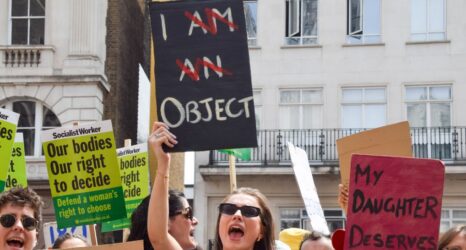More than 30 percent of girls in the juvenile justice system have been sexually abused, according to a new study issued by the Human Rights Project for Girls, the Georgetown Law Center on Poverty and Inequality and the Ms. Foundation for Women. The study also found that LGBTQ girls and girls of color are disproportionately, and increasingly, represented in the juvenile justice system.
Girls are often funneled through a sexual-abuse-to-prison pipeline, the report says. They often end up in the system as a result of sexual victimization, such as when sex trafficking survivors are arrested on prostitution charges, and then are denied resources to identify and treat their trauma.
Girls are most often arrested for crimes such as running away, substance abuse and truancy—acts child abuse experts frequently name as signs of abuse. Moreover, women offenders tend to self-report their victimization “as a key factor leading to their offending,” the researchers found.
According to the report, which looked at both regional and national data, justice-involved girls:
- are dramatically more likely than justice-involved boys to have been sexually abused
- are most likely to be “fondled or molested” at age 5
- tend to be charged again after release if they have been sexually abused, while sexually abused boys do not
When these girls are arrested and charged instead of supported, the study contends, their abusers go unpunished and their trauma unrecognized. This leads to devastatingly dismal mental health outcomes in many girls, including depression and post-traumatic stress disorder (PTSD): In a 2004 study, the National Child Traumatic Stress Network (NCTSN) discovered that over 65 percent of justice-involved girls had experienced PTSD symptoms at some point in their lives.
In addition, juvenile justice facilities frequently lack the resources necessary to care for abused girls, both in terms of mental and physical health. Not only are half of justice-involved youth placed into facilities that do not provide mental health evaluations for all residents, but 88 percent live in facilities that lack professional licenses for their mental health counselors. Meanwhile, while sexually abused girls are significantly more likely to have been or be pregnant upon incarceration, the Department of Justice’s Office of Juvenile Justice and Delinquency Prevention (OJJDP) found that only 18 percent of juvenile justice facilities provide pregnancy testing at entry.
The report makes several practical and legislative recommendations for dismantling the sexual-abuse-to-prison pipeline, including reevaluating the potentially traumatic effects of routine procedures such as strip-searching; continuing treatment for trauma after leaving the system; and providing gender-specific physical and mental health care, such as comprehensive reproductive care.
The child welfare system also needs significant change, the study finds, because girls who have encountered it are much more likely to end up in the juvenile justice system. Known as “the crossover path,” this trend disproportionally affects girls of color.
Yet the links between sexual abuse, race and gender in the juvenile justice system remain largely unexplored due to a lack of national and intersectional research.
“And when we lack the most basic information about girls’ unique needs and what is happening in their lives, especially against the backdrop of high rates of sexual violence,” the study’s conclusion declares, “the battle to develop effective strategies for their health is an uphill one.”
Photo via Shutterstock





